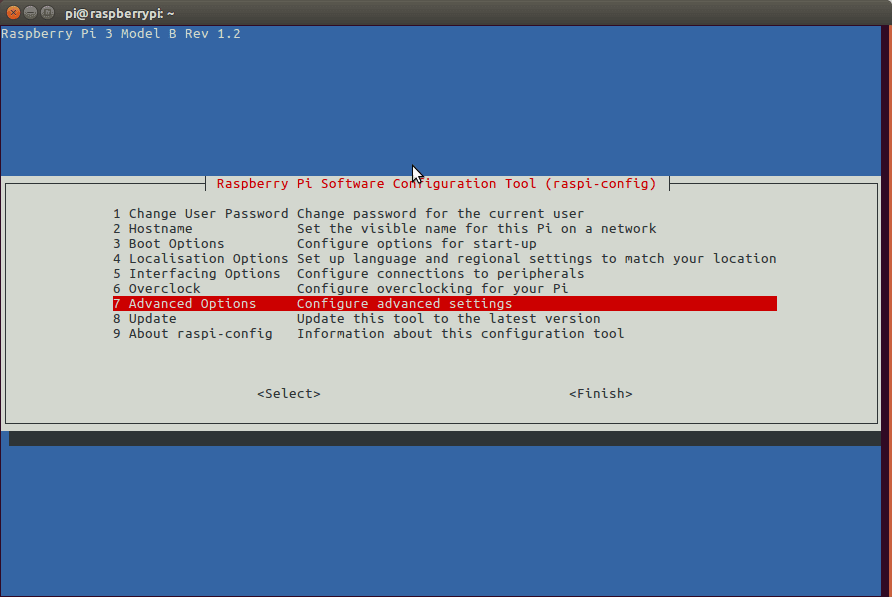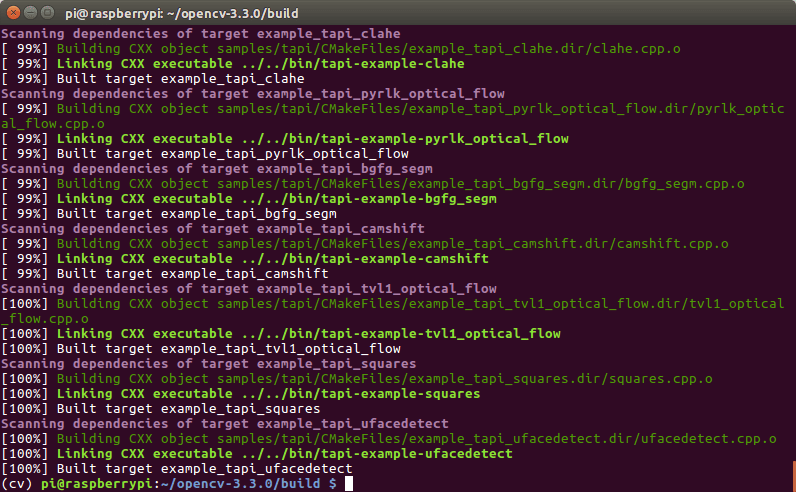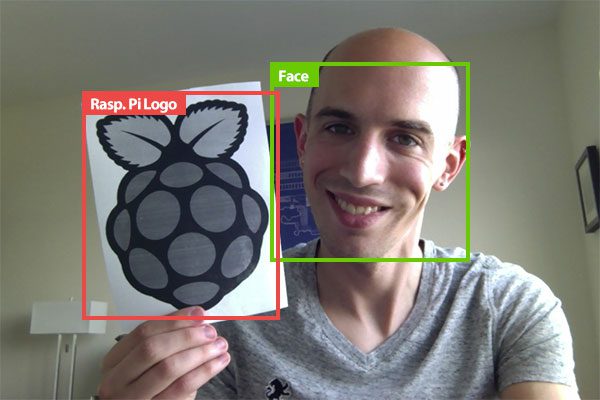
It’s been over two years since the release of Raspbian Jessie. As of August 17th, 2017, the Raspberry Pi foundation has officially released the successor to Raspbian Jessie — Raspbian Stretch.
Just as I have done in previous blog posts, I’ll be demonstrating how to install OpenCV 3 with Python bindings on Raspbian Stretch.
If you are looking for previous installation instructions for different platforms, please consult this list:
- Install guide: Raspberry Pi 3 + Raspbian Jessie + OpenCV 3
- How to install OpenCV 3.0 on Raspbian Jessie.
- Installing OpenCV on your Raspberry Pi Zero running Raspbian Jessie.
- Installing OpenCV 3.0 for both Python 2.7 and Python 3+ on Raspbian Wheezy.
- Install OpenCV 2.4 for Python 2.7 on Raspbian Wheezy.
Otherwise, let’s proceed with getting OpenCV 3 with Python bindings installed on Raspian Stretch!
The quick start video tutorial
If this is your first time installing OpenCV or you are just getting started with Linux I highly suggest that you watch the video below and follow along with me as you guide you step-by-step on how to install OpenCV 3 on your Raspberry Pi running Raspbian Stretch:
Otherwise, if you feel comfortable using the command line or if you have previous experience with Linux environments, feel free to use the text-based version of this guide below.
Assumptions
In this tutorial, I am going to assume that you already own a Raspberry Pi 3 with Raspbian Stretch installed.
If you don’t already have the Raspbian Stretch OS, you’ll need to upgrade your OS to take advantage of Raspbian Stretch’s new features.
To upgrade your Raspberry Pi 3 to Raspbian Stretch, you may download it here and follow these upgrade instructions (or these for the NOOBS route which is recommended for beginners). The former instructions take approximately 10 minutes to download via a torrent client and about 10 minutes to flash the SD card at which point you can power up and proceed to the next section.
Note: If you are upgrading your Raspberry Pi 3 from Raspbian Jessie to Raspbian Stretch, there is the potential for problems. Proceed at your own risk, and consult the Raspberry Pi forums for help.
Important: It is my recommendation that you proceed with a fresh install of Raspbian Stretch! Upgrading from Raspbian Jessie is not recommended.
Assuming that your OS is up to date, you’ll need one of the following for the remainder of this post:
- Physical access to your Raspberry Pi 3 so that you can open up a terminal and execute commands
- Remote access via SSH or VNC.
I’ll be doing the majority of this tutorial via SSH, but as long as you have access to a terminal, you can easily follow along.
Can’t SSH? If you see your Pi on your network, but can’t ssh to it, you may need to enable SSH. This can easily be done via the Raspberry Pi desktop preferences menu (you’ll need an HDMI cable and a keyboard/mouse) or running
sudo service ssh startfrom the command line of your Pi.
After you’ve changed the setting and rebooted, you can test SSH directly on the Pi with the localhost address. Open a terminal and type
ssh pi@127.0.0.1to see if it is working.
Keyboard layout giving you problems? Change your keyboard layout by going to the Raspberry Pi desktop preferences menu. I use the standard US Keyboard layout, but you’ll want to select the one appropriate for your keyboard or desire (any Dvorkac users out there?).
Installing OpenCV 3 on a Raspberry Pi 3 running Raspbian Stretch
If you’ve ever installed OpenCV on a Raspberry Pi (or any other platform before), you know that the process can be quite time consuming with many dependencies and pre-requisites that have to be installed. The goal of this tutorial is to thus guide you step-by-step through the compile and installation process.
In order to make the installation process go more smoothly, I’ve included timings for each step so you know when to take a break, grab a cup of coffee, and checkup on email while the Pi compiles OpenCV.
Let’s go ahead and get started installing OpenCV 3 on your Raspberry Pi 3 running Raspbian Stretch.
Step #1: Expand filesystem
Are you using a brand new install of Raspbian Stretch?
If so, the first thing you should do is expand your filesystem to include all available space on your micro-SD card:
$ sudo raspi-config
And then select the “Advanced Options” menu item:
Followed by selecting “Expand filesystem”:
Once prompted, you should select the first option, “A1. Expand File System”, hit Enter on your keyboard, arrow down to the “<Finish>” button, and then reboot your Pi — you may be prompted to reboot, but if you aren’t you can execute:
$ sudo reboot
After rebooting, your file system should have been expanded to include all available space on your micro-SD card. You can verify that the disk has been expanded by executing
df -hand examining the output:
$ df -h Filesystem Size Used Avail Use% Mounted on /dev/root 30G 4.2G 24G 15% / devtmpfs 434M 0 434M 0% /dev tmpfs 438M 0 438M 0% /dev/shm tmpfs 438M 12M 427M 3% /run tmpfs 5.0M 4.0K 5.0M 1% /run/lock tmpfs 438M 0 438M 0% /sys/fs/cgroup /dev/mmcblk0p1 42M 21M 21M 51% /boot tmpfs 88M 0 88M 0% /run/user/1000
As you can see, my Raspbian filesystem has been expanded to include all 32GB of the micro-SD card.
However, even with my filesystem expanded, I have already used 15% of my 32GB card.
If you are using an 8GB card you may be using close to 50% of the available space, so one simple thing to do is to delete both LibreOffice and Wolfram engine to free up some space on your Pi:
$ sudo apt-get purge wolfram-engine $ sudo apt-get purge libreoffice* $ sudo apt-get clean $ sudo apt-get autoremove
After removing the Wolfram Engine and LibreOffice, you can reclaim almost 1GB!
Step #2: Install dependencies
This isn’t the first time I’ve discussed how to install OpenCV on the Raspberry Pi, so I’ll keep these instructions on the briefer side, allowing you to work through the installation process: I’ve also included the amount of time it takes to execute each command (some depend on your Internet speed) so you can plan your OpenCV + Raspberry Pi 3 install accordingly (OpenCV itself takes approximately 4 hours to compile — more on this later).
The first step is to update and upgrade any existing packages:
$ sudo apt-get update && sudo apt-get upgrade
Timing: 2m 14s
We then need to install some developer tools, including CMake, which helps us configure the OpenCV build process:
$ sudo apt-get install build-essential cmake pkg-config
Timing: 19s
Next, we need to install some image I/O packages that allow us to load various image file formats from disk. Examples of such file formats include JPEG, PNG, TIFF, etc.:
$ sudo apt-get install libjpeg-dev libtiff5-dev libjasper-dev libpng12-dev
Timing: 21s
Just as we need image I/O packages, we also need video I/O packages. These libraries allow us to read various video file formats from disk as well as work directly with video streams:
$ sudo apt-get install libavcodec-dev libavformat-dev libswscale-dev libv4l-dev $ sudo apt-get install libxvidcore-dev libx264-dev
Timing: 32s
The OpenCV library comes with a sub-module named
highguiwhich is used to display images to our screen and build basic GUIs. In order to compile the
highguimodule, we need to install the GTK development library:
$ sudo apt-get install libgtk2.0-dev libgtk-3-dev
Timing: 1m 36s
Many operations inside of OpenCV (namely matrix operations) can be optimized further by installing a few extra dependencies:
$ sudo apt-get install libatlas-base-dev gfortran
Timing: 23s
These optimization libraries are especially important for resource constrained devices such as the Raspberry Pi.
Lastly, let’s install both the Python 2.7 and Python 3 header files so we can compile OpenCV with Python bindings:
$ sudo apt-get install python2.7-dev python3-dev
Timing: 45s
If you’re working with a fresh install of the OS, it is possible that these versions of Python are already at the newest version (you’ll see a terminal message stating this).
If you skip this step, you may notice an error related to the
Python.hheader file not being found when running
maketo compile OpenCV.
Step #3: Download the OpenCV source code
Now that we have our dependencies installed, let’s grab the
3.3.0archive of OpenCV from the official OpenCV repository. This version includes the
dnnmodule which we discussed in a previous post where we did Deep Learning with OpenCV (Note: As future versions of openCV are released, you can replace
3.3.0with the latest version number):
$ cd ~ $ wget -O opencv.zip https://github.com/Itseez/opencv/archive/3.3.0.zip $ unzip opencv.zip
Timing: 41s
We’ll want the full install of OpenCV 3 (to have access to features such as SIFT and SURF, for instance), so we also need to grab the opencv_contrib repository as well:
$ wget -O opencv_contrib.zip https://github.com/Itseez/opencv_contrib/archive/3.3.0.zip $ unzip opencv_contrib.zip
Timing: 37s
You might need to expand the command above using the “<=>” button during your copy and paste. The
.zipin the
3.3.0.zipmay appear to be cutoff in some browsers. The full URL of the OpenCV 3.3.0 archive is:
https://github.com/Itseez/opencv_contrib/archive/3.3.0.zip
Note: Make sure your opencv
and opencv_contrib
versions are the same (in this case, 3.3.0
). If the versions numbers do not match up, then you’ll likely run into either compile-time or runtime errors.
Step #4: Python 2.7 or Python 3?
Before we can start compiling OpenCV on our Raspberry Pi 3, we first need to install
pip, a Python package manager:
$ wget https://bootstrap.pypa.io/get-pip.py $ sudo python get-pip.py $ sudo python3 get-pip.py
Timing: 33s
You may get a message that pip is already up to date when issuing these commands, but it is best not to skip this step.
If you’re a longtime PyImageSearch reader, then you’ll know that I’m a huge fan of both virtualenv and virtualenvwrapper. Installing these packages is not a requirement and you can absolutely get OpenCV installed without them, but that said, I highly recommend you install them as other existing PyImageSearch tutorials (as well as future tutorials) also leverage Python virtual environments. I’ll also be assuming that you have both
virtualenvand
virtualenvwrapperinstalled throughout the remainder of this guide.
So, given that, what’s the point of using virtualenv
and virtualenvwrapper
?
First, it’s important to understand that a virtual environment is a special tool used to keep the dependencies required by different projects in separate places by creating isolated, independent Python environments for each of them.
In short, it solves the “Project X depends on version 1.x, but Project Y needs 4.x” dilemma. It also keeps your global
site-packagesneat, tidy, and free from clutter.
If you would like a full explanation on why Python virtual environments are good practice, absolutely give this excellent blog post on RealPython a read.
It’s standard practice in the Python community to be using virtual environments of some sort, so I highly recommend that you do the same:
$ sudo pip install virtualenv virtualenvwrapper $ sudo rm -rf ~/.cache/pip
Timing: 35s
Now that both
virtualenvand
virtualenvwrapperhave been installed, we need to update our
~/.profilefile to include the following lines at the bottom of the file:
# virtualenv and virtualenvwrapper export WORKON_HOME=$HOME/.virtualenvs source /usr/local/bin/virtualenvwrapper.sh
In previous tutorials, I’ve recommended using your favorite terminal-based text editor such as
vim,
emacs, or
nanoto update the
~/.profilefile. If you’re comfortable with these editors, go ahead and update the file to reflect the changes mentioned above.
Otherwise, you should simply use
catand output redirection to handle updating
~/.profile:
$ echo -e "\n# virtualenv and virtualenvwrapper" >> ~/.profile $ echo "export WORKON_HOME=$HOME/.virtualenvs" >> ~/.profile $ echo "source /usr/local/bin/virtualenvwrapper.sh" >> ~/.profile
Now that we have our
~/.profileupdated, we need to reload it to make sure the changes take affect. You can force a reload of your
~/.profilefile by:
- Logging out and then logging back in.
- Closing a terminal instance and opening up a new one
- Or my personal favorite, just use the
source
command:
$ source ~/.profile
Note: I recommend running the source ~/.profile
file each time you open up a new terminal to ensure your system variables have been setup correctly.
Creating your Python virtual environment
Next, let’s create the Python virtual environment that we’ll use for computer vision development:
$ mkvirtualenv cv -p python2
This command will create a new Python virtual environment named
cvusing Python 2.7.
If you instead want to use Python 3, you’ll want to use this command instead:
$ mkvirtualenv cv -p python3
Timing: 24s
Again, I can’t stress this point enough: the
cvPython virtual environment is entirely independent and sequestered from the default Python version included in the download of Raspbian Stretch. Any Python packages in the global
site-packagesdirectory will not be available to the
cvvirtual environment. Similarly, any Python packages installed in
site-packagesof
cvwill not be available to the global install of Python. Keep this in mind when you’re working in your Python virtual environment and it will help avoid a lot of confusion and headaches.
How to check if you’re in the “cv” virtual environment
If you ever reboot your Raspberry Pi; log out and log back in; or open up a new terminal, you’ll need to use the
workoncommand to re-access the
cvvirtual environment. In previous blog posts, I’ve seen readers use the
mkvirtualenvcommand — this is entirely unneeded! The
mkvirtualenvcommand is meant to be executed only once: to actually create the virtual environment.
After that, you can use
workonand you’ll be dropped down into your virtual environment:
$ source ~/.profile $ workon cv
To validate and ensure you are in the
cvvirtual environment, examine your command line — if you see the text
(cv)preceding your prompt, then you are in the
cvvirtual environment:
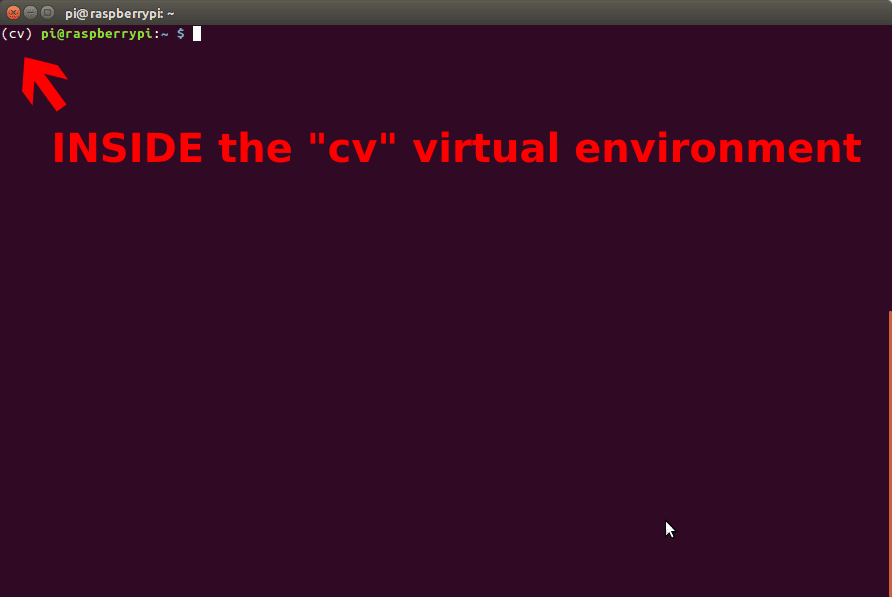
Figure 3: Make sure you see the “(cv)” text on your prompt, indicating that you are in the cv virtual environment.
Otherwise, if you do not see the
(cv)text, then you are not in the
cvvirtual environment:
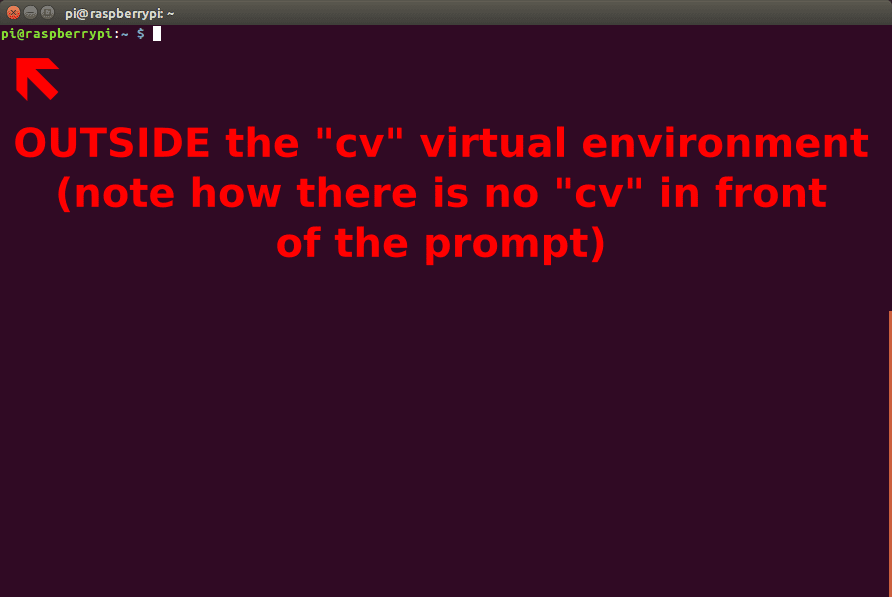
Figure 4: If you do not see the “(cv)” text on your prompt, then you are not in the cv virtual environment and need to run “source” and “workon” to resolve this issue.
To fix this, simply execute the
sourceand
workoncommands mentioned above.
Installing NumPy on your Raspberry Pi
Assuming you’ve made it this far, you should now be in the
cvvirtual environment (which you should stay in for the rest of this tutorial). Our only Python dependency is NumPy, a Python package used for numerical processing:
$ pip install numpy
Timing: 11m 12s
Be sure to grab a cup of coffee or go for a nice walk, the NumPy installation can take a bit of time.
Note: A question I’ve often seen is “Help, my NumPy installation has hung and it’s not installing!” Actually, it is installing, it just takes time to pull down the sources and compile. You can verify that NumPy is compiling and installing by running top
. Here you’ll see that your CPU cycles are being used compiling NumPy. Be patient. The Raspberry Pi isn’t as fast as your laptop/desktop.
Step #5: Compile and Install OpenCV
We are now ready to compile and install OpenCV! Double-check that you are in the
cvvirtual environment by examining your prompt (you should see the
(cv)text preceding it), and if not, simply execute
workon:
$ workon cv
Once you have ensured you are in the
cvvirtual environment, we can setup our build using CMake:
$ cd ~/opencv-3.3.0/
$ mkdir build
$ cd build
$ cmake -D CMAKE_BUILD_TYPE=RELEASE \
-D CMAKE_INSTALL_PREFIX=/usr/local \
-D INSTALL_PYTHON_EXAMPLES=ON \
-D OPENCV_EXTRA_MODULES_PATH=~/opencv_contrib-3.3.0/modules \
-D BUILD_EXAMPLES=ON ..Timing: 2m 56s
Now, before we move on to the actual compilation step, make sure you examine the output of CMake!
Start by scrolling down the section titled
Python 2and
Python 3.
If you are compiling OpenCV 3 for Python 2.7, then make sure your
Python 2section includes valid paths to the
Interpreter,
Libraries,
numpyand
packages path, similar to my screenshot below:
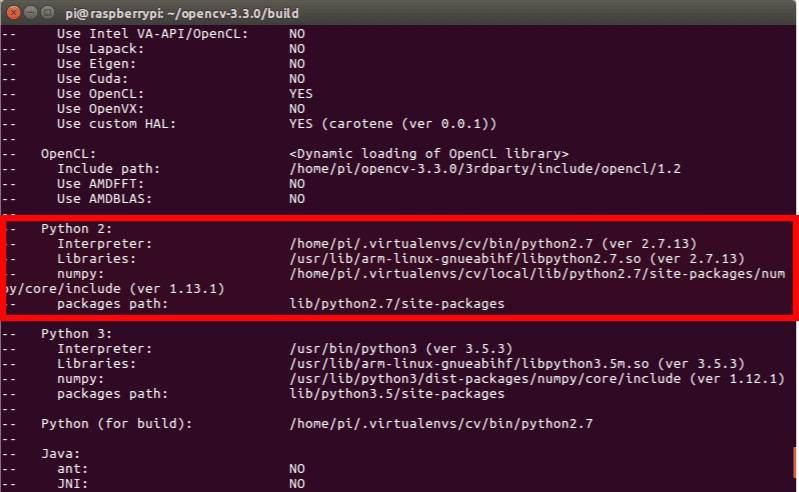
Figure 6: Checking that Python 3 will be used when compiling OpenCV 3 for Raspbian Stretch on the Raspberry Pi 3.
Notice how the
Interpreterpoints to our
python2.7binary located in the
cvvirtual environment. The
numpyvariable also points to the NumPy installation in the
cvenvironment.
Similarly, if you’re compiling OpenCV for Python 3, make sure the
Python 3section looks like the figure below:
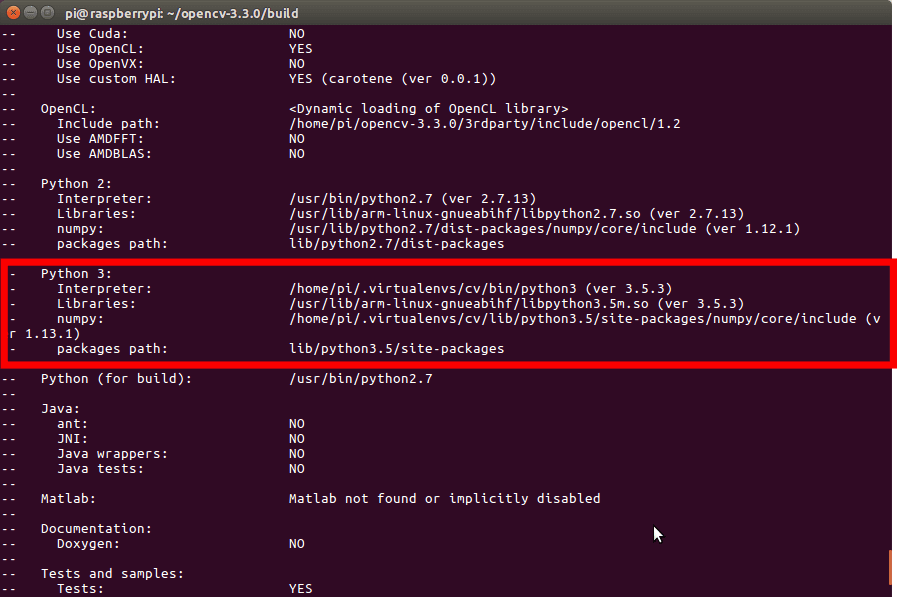
Figure 6: Checking that Python 3 will be used when compiling OpenCV 3 for Raspbian Stretch on the Raspberry Pi 3.
Again, the
Interpreterpoints to our
python3.5binary located in the
cvvirtual environment while
numpypoints to our NumPy install.
In either case, if you do not see the
cvvirtual environment in these variables paths, it’s almost certainly because you are NOT in the
cvvirtual environment prior to running CMake!
If this is the case, access the
cvvirtual environment using
workon cvand re-run the
cmakecommand outlined above.
Finally, we are now ready to compile OpenCV:
$ make
Timing: 4h 0m
I was not able to successfully leverage compiling with 2 or 4 cores (the Pi 3 has 4 cores) which would significantly cut down on compile time (previous posts here on PyImageSearch demonstrate that OpenCV and be compiled in a little over 60 minutes).
I recommend you not compile with
make -j2or
make -j4as your compile will likely freeze up at 90%. I have not been able to diagnose whether this is an issue with (1) the Pi overheating, (2) a race condition with the compile, (3) the Raspbian Stretch OS, or some combination of all three. Based on all my experimentations thus far I think it’s an issue introduced with the Raspbian Stretch OS.
If you do have a compile error using
-j2or
-j4, I suggest starting the compilation over again and using only one core:
$ make clean $ make
Once OpenCV 3 has finished compiling, your output should look similar to mine below:
From there, all you need to do is install OpenCV 3 on your Raspberry Pi 3:
$ sudo make install $ sudo ldconfig
Timing: 52s
Step #6: Finish installing OpenCV on your Pi
We’re almost done — just a few more steps to go and you’ll be ready to use your Raspberry Pi 3 with OpenCV 3 on Raspbian Stretch.
For Python 2.7:
Provided your Step #5 finished without error, OpenCV should now be installed in
/usr/local/lib/python2.7/site-pacakges. You can verify this using the
lscommand:
$ ls -l /usr/local/lib/python2.7/site-packages/ total 1852 -rw-r--r-- 1 root staff 1895772 Mar 20 20:00 cv2.so
Note: In some cases, OpenCV can be installed in /usr/local/lib/python2.7/dist-packages
(note the dist-packages
rather than site-packages
). If you do not find the cv2.so
bindings in site-packages
, we be sure to check dist-packages
.
Our final step is to sym-link the OpenCV bindings into our
cvvirtual environment for Python 2.7:
$ cd ~/.virtualenvs/cv/lib/python2.7/site-packages/ $ ln -s /usr/local/lib/python2.7/site-packages/cv2.so cv2.so
For Python 3:
After running
make install, your OpenCV + Python bindings should be installed in
/usr/local/lib/python3.5/site-packages. Again, you can verify this with the
lscommand:
$ ls -l /usr/local/lib/python3.5/site-packages/ total 1852 -rw-r--r-- 1 root staff 1895932 Mar 20 21:51 cv2.cpython-34m.so
I honestly don’t know why, perhaps it’s a bug in the CMake script, but when compiling OpenCV 3 bindings for Python 3+, the output
.sofile is named
cv2.cpython-35m-arm-linux-gnueabihf.so(or some variant of) rather than simply
cv2.so(like in the Python 2.7 bindings).
Again, I’m not sure exactly why this happens, but it’s an easy fix. All we need to do is rename the file:
$ cd /usr/local/lib/python3.5/site-packages/ $ sudo mv cv2.cpython-35m-arm-linux-gnueabihf.so cv2.so
After renaming to
cv2.so, we can sym-link our OpenCV bindings into the
cvvirtual environment for Python 3.5:
$ cd ~/.virtualenvs/cv/lib/python3.5/site-packages/ $ ln -s /usr/local/lib/python3.5/site-packages/cv2.so cv2.so
Step #7: Testing your OpenCV 3 install
Congratulations, you now have OpenCV 3 installed on your Raspberry Pi 3 running Raspbian Stretch!
But before we pop the champagne and get drunk on our victory, let’s first verify that your OpenCV installation is working properly.
Open up a new terminal, execute the
sourceand
workoncommands, and then finally attempt to import the Python + OpenCV bindings:
$ source ~/.profile $ workon cv $ python >>> import cv2 >>> cv2.__version__ '3.3.0' >>>
As you can see from the screenshot of my own terminal, OpenCV 3 has been successfully installed on my Raspberry Pi 3 + Python 3.5 environment:
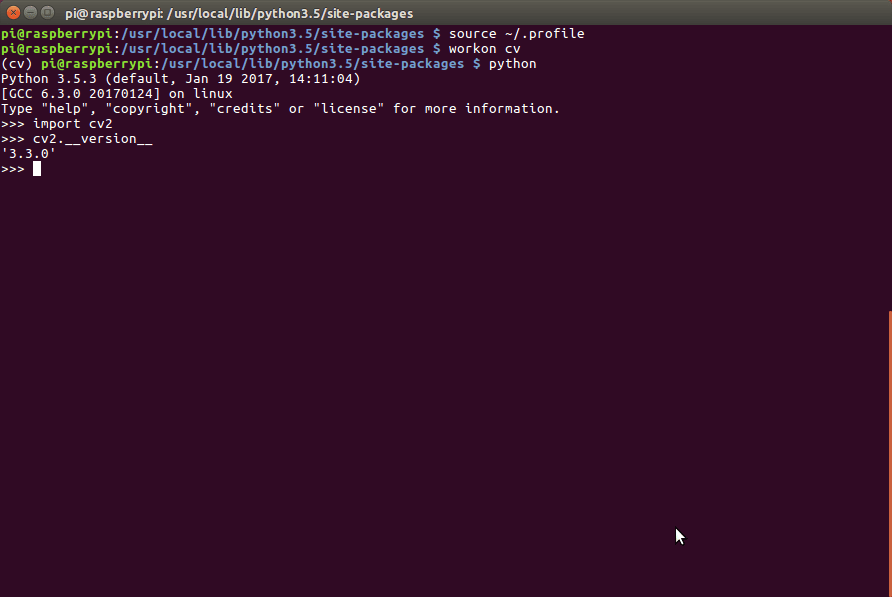
Figure 8: Confirming OpenCV 3 has been successfully installed on my Raspberry Pi 3 running Raspbian Stretch.
Once OpenCV has been installed, you can remove both the
opencv-3.3.0and
opencv_contrib-3.3.0directories to free up a bunch of space on your disk:
$ rm -rf opencv-3.3.0 opencv_contrib-3.3.0
However, be cautious with this command! Make sure OpenCV has been properly installed on your system before blowing away these directories. A mistake here could cost you hours in compile time.
Troubleshooting and FAQ
Q. When I try to execute
mkvirtualenvand
workon, I get a “command not found error”.
A. There are three reasons why this could be happening, all of them related to Step #4:
- Make certain that you have installed
virtualenv
andvirtualenvwrapper
viapip
. You can check this by runningpip freeze
and then examining the output, ensuring you see occurrences of bothvirtualenv
andvirtualenvwrapper
. - You might not have updated your
~/.profile
correctly. Use a text editor such asnano
to view your~/.profile
file and ensure that the properexport
andsource
commands are present (again, check Step #4 for the contents that should be appended to~/.profile
. - You did not
source
your~/.profile
after editing it, rebooting, opening a new terminal, etc. Any time you open a new terminal and want to use a virtual environment, make sure you executesource ~/.profile
to load the contents — this will give you access to themkvirtualenv
andworkon
commands.
Q. After I open a new terminal, logout, or reboot my Pi, I cannot execute
mkvirtualenvor
workon.
A. See reason #3 from the previous question.
Q. When I (1) open up a Python shell that imports OpenCV or (2) execute a Python script that calls OpenCV, I get an error:
ImportError: No module named cv2.
A. Unfortunately, this error is extremely hard to diagnose, mainly because there are multiple issues that could be causing the problem. To start, make sure you are in the
cvvirtual environment by using
workon cv. If the
workoncommand fails, then see the first question in this FAQ. If you’re still getting an error, investigate the contents of the
site-packagesdirectory for your
cvvirtual environment. You can find the
site-packagesdirectory in
~/.virtualenvs/cv/lib/python2.7/site-packages/or
~/.virtualenvs/cv/lib/python3.5/site-packages/(depending on which Python version you used for the install). Make sure that your sym-link to the
cv2.sofile is valid and points to an existing file.
Q. I’m running into other errors.
A. Feel free to leave a comment and I’ll try to provide guidance; however, please understand that without physical access to your Pi it can often be hard to diagnose compile/install errors. If you’re in a rush to get OpenCV up and running on your Raspberry Pi be sure to take a look at the Quickstart Bundle and Hardcopy Bundle of my book, Practical Python and OpenCV. Both of these bundles include a Raspbian .img file with OpenCV pre-configured and pre-installed. Simply download the .img file, flash it to your Raspberry Pi, and boot! This method is by far the easiest, hassle free method to getting started with OpenCV on your Raspberry Pi.
So, what’s next?
Congrats! You have a brand new, fresh install of OpenCV on your Raspberry Pi — and I’m sure you’re just itching to leverage your Raspberry Pi to build some awesome computer vision apps.
But I’m also willing to bet that you’re just getting started learning computer vision and OpenCV, and you’re probably feeling a bit confused and overwhelmed on where exactly to start.
Personally, I’m a big fan of learning by example, so a good first step would be to read this blog post on accessing your Raspberry Pi Camera with the picamera module. This tutorial details the exact steps you need to take to (1) capture photos from the camera module and (2) access the raw video stream.
And if you’re really interested in leveling-up your computer vision skills, you should definitely check out my book, Practical Python and OpenCV + Case Studies. My book not only covers the basics of computer vision and image processing, but also teaches you how to solve real world computer vision problems including face detection in images and video streams, object tracking in video, and handwriting recognition.
All code examples covered in the book are guaranteed to run on the Raspberry Pi 2 and Pi 3 as well! Most programs will also run on the B+ and Zero models, but might be a bit slow due to the limited computing power of the B+ and Zero.
So let’s put your fresh install of OpenCV on your Raspberry Pi to good use — just click here to learn more about the real-world projects you can solve using your Raspberry Pi + Practical Python and OpenCV .
Summary
In this blog post, we learned how to upgrade your Raspberry Pi 3‘s OS to Raspbian Stretch and to install OpenCV 3 with either Python 2.7 or Python 3 bindings.
If you are running a different version of Raspbian (such as Raspbian Wheezy) or want to install a different version of OpenCV (such as OpenCV 2.4), please consult the following tutorials:
- Install guide: Raspberry Pi 3 + Raspbian Jessie + OpenCV 3
- How to install OpenCV 3.0 on Raspbian Jessie.
- Installing OpenCV on your Raspberry Pi Zero running Raspbian Jessie.
- Installing OpenCV 3.0 for both Python 2.7 and Python 3+ on Raspbian Wheezy.
- Install OpenCV 2.4 for Python 2.7 on Raspbian Wheezy.
Are you looking for a project to work on with your new install of OpenCV on Raspbian Stretch? Readers have been big fans of this post on Home surveillance and motion detection with the Raspberry Pi, Python, OpenCV, and Dropbox.
But before you go…
I tend to utilize the Raspberry Pi quite a bit on this blog, so if you’re interested in learning more about the Raspberry Pi + computer vision, enter your email address in the form below to be notified when these posts go live!
The post Raspbian Stretch: Install OpenCV 3 + Python on your Raspberry Pi appeared first on PyImageSearch.
